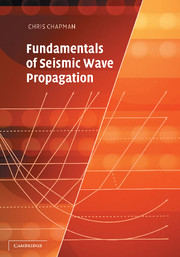Book contents
- Frontmatter
- Contents
- Preface
- Preliminaries
- 1 Introduction
- 2 Basic wave propagation
- 3 Transforms
- 4 Review of continuum mechanics and elastic waves
- 5 Asymptotic ray theory
- 6 Rays at an interface
- 7 Differential systems for stratified media
- 8 Inverse transforms for stratified media
- 9 Canonical signals
- 10 Generalizations of ray theory
- Appendices
- Bibliography
- Author index
- Subject index
5 - Asymptotic ray theory
Published online by Cambridge University Press: 19 January 2010
- Frontmatter
- Contents
- Preface
- Preliminaries
- 1 Introduction
- 2 Basic wave propagation
- 3 Transforms
- 4 Review of continuum mechanics and elastic waves
- 5 Asymptotic ray theory
- 6 Rays at an interface
- 7 Differential systems for stratified media
- 8 Inverse transforms for stratified media
- 9 Canonical signals
- 10 Generalizations of ray theory
- Appendices
- Bibliography
- Author index
- Subject index
Summary
Ray theory is the cornerstone of high-frequency, body-wave seismology. Without it, seismic signals in realistic, complex media would be extremely difficult to describe and interpret. The mathematical technique of asymptotic ray theory is developed in this chapter. Although the details appear complicated, e.g. the higher-order terms in dynamic ray theory, it must be remembered that usually only the lowest-order terms are needed and used. These are relatively easy to understand and compute. Ray theory in a continuous medium consists of three parts which are developed in this chapter for acoustic, isotropic and anisotropic elastic media: kinematic ray theory that describes the geometry and times of rays and wavefronts; dynamic ray theory that describes the geometrical spreading of rays and the displacement magnitude; and polarization theory describing the displacement direction. The chapter concludes with a pretty example of ray tracing in an anisotropic medium with a linear gradient, which illustrates that even in this simple example, complicated non-intuitive results occur.
In this chapter, we develop asymptotic ray theory (ART) for acoustic, anisotropic and isotropic media. We use the equations of motion, and the constitutive relations already discussed in Chapter 4, without the source terms, and match the ray solutions to the point-source Green function given in Section 4.5.5. We discuss anisotropic, elastic waves before specializing to isotropic media, as the development is actually more straightforward. The degenerate shear waves in isotropic media require special treatment.
Information
- Type
- Chapter
- Information
- Fundamentals of Seismic Wave Propagation , pp. 134 - 197Publisher: Cambridge University PressPrint publication year: 2004
